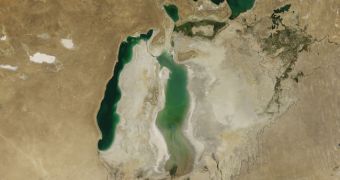Central Asia once housed the fourth largest lake in the world, called the Aral Sea. Since the 1960s however, large Soviet irrigation projects diverted the rivers that fed the sea, and the body of water is now all but gone.
The Aral Sea is located between Kazakhstan and Uzbekistan, and once covered an area of 68,000 square kilometers (26,000 square miles). More than 1,500 islands dotted its surface.
In the past, there were two main rivers that were fueling the sea, the Amu Darya and the Syr Darya. The former was the largest contributor, and also the largest body of flowing water in the area.
The Amu Darya was therefore the first to be diverted by massive irrigation initiatives undertaken by the former Soviet Union in the area, which is very arid, and also prone to droughts.
The Amu also changed its own course, sometimes in ancient history, experts say, when it started emptying in the Caspian Sea. The Aral Sea immediately shrunk as a direct result.
In more recent times, the Syr Darya remained the only source of water for the lake, but it too was diverted for agriculture and irrigations, which means that the volume of water reaching the Aral Sea diminished once more.
But this time the reduction proved “fatal” for the lake. After 2000, its extent dropped massively, separating the former sea into three main lakes, and making many of the islands turn into peninsula, and then into elevated dry land.
The image attached to this article was snapped on August 26, 2010, using the Moderate Resolution Imaging Spectroradiometer (MODIS) instrument on the NASA Terra satellite.
It clearly shows that the drought which affected the region between 2006 and 2009 had a devastating effect on the sea, given that not all of the water in the Amu Darya reached the Aral Sea.
The river gets its waters from the Pamir River, which itself comes from Lake Zorkul (once also known as Lake Victoria), that is located in the area along the border between Afghanistan and Tajikistan
Authorities in all countries in the region decided to pledge about 1 percent of their GDP to resotring the Aral Sea, but at this point this is a monumental task.
One of the restoration plans calls for redirecting large amounts of water from the Volga, Ob and Irtysh rivers. The plan would restore the sea to its former size in up to 20–30 years, and could cost as much as $30–50 billion.
Installing dams could also be a feasible option, but costs associated with dam-building are very large. Another solution would be to force cotton farmers in the area to use rivers rather than the sea, thus avoiding unnecessary consumption.

 14 DAY TRIAL //
14 DAY TRIAL //